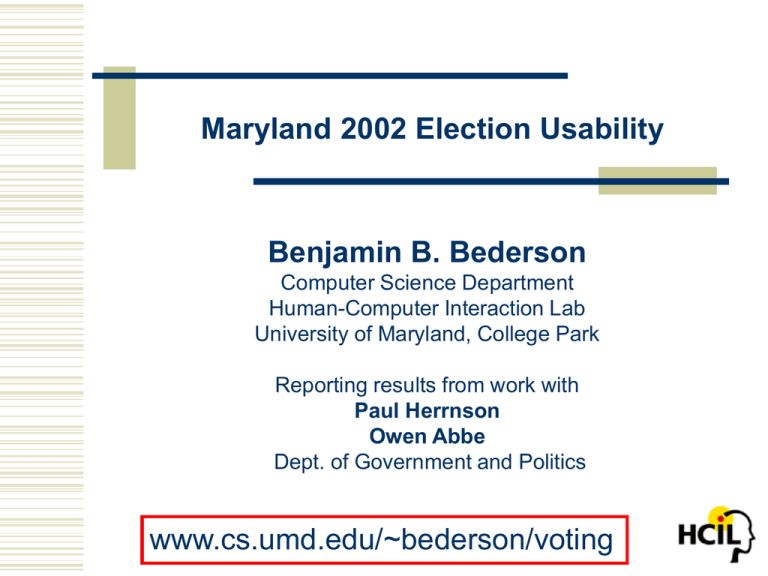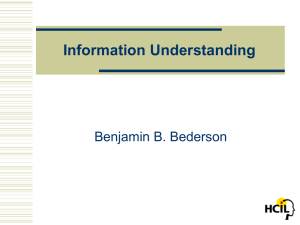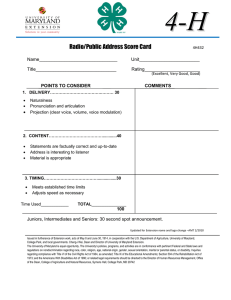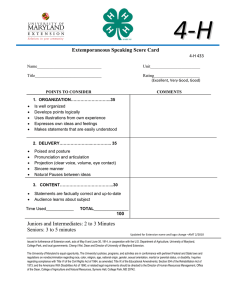Maryland 2002 Election Usability Benjamin B. Bederson
advertisement

Maryland 2002 Election Usability Benjamin B. Bederson Computer Science Department Human-Computer Interaction Lab University of Maryland, College Park Reporting results from work with Paul Herrnson Owen Abbe Dept. of Government and Politics www.cs.umd.edu/~bederson/voting 2002 Election Exit Poll Montgomery & Prince George’s Counties University of Maryland, Human-Computer Interaction Laboratory Administered broad exit poll questionnaire 1,276 respondents 22 precincts in two counties response rate was 74.6% Summary: Majority like new system But significant minority have concerns Diebold AccuVote-TS Deployed at 2002 General Election University of Maryland, Human-Computer Interaction Laboratory University of Maryland, Human-Computer Interaction Laboratory University of Maryland, Human-Computer Interaction Laboratory University of Maryland, Human-Computer Interaction Laboratory University of Maryland, Human-Computer Interaction Laboratory University of Maryland, Human-Computer Interaction Laboratory Voter Acceptance University of Maryland, Human-Computer Interaction Laboratory The voting system was easy I was comfortable using the system Characters on the screen were easy to read Terminology on screen was precise Correcting my mistakes was easy I am confident that my vote was accurately recorded 94% 93% 94% 93% 91% 90% Voter Trust University of Maryland, Human-Computer Interaction Laboratory Previously, voters had used punch cards or mechanical lever systems. I trust the previous voting machine I trust the touch screen voting machine 71% 91% Problems Using the System University of Maryland, Human-Computer Interaction Laboratory Asked for help using the machine Received help using the machine Experienced technical problems 9% 17% 3% Election officials are pro-active Most technical problems are with cards Navigation was troublesome – sometimes jumping multiple screens Couldn’t change language after selection Ballot review with scrollbar was difficult Usability and Assistance by Computer Use University of Maryland, Human-Computer Interaction Laboratory Usability and Assistance 100% 80% Frequence of Computer Use <= 1/month 60% Frequence of Computer Use 2/month - 2/week 40% Frequence of Computer Use >= 3/week 20% Got help using machine Asked for help using machine Terminology was precise 0% Voting system easy to use Percentage Reporting 120% Frequency of Computer Use Assistance by Education University of Maryland, Human-Computer Interaction Laboratory Assistance by Education 35% 30% Percent received 25% 20% No college Some college to BS 15% Graduate school 10% 5% 0% Asked for help Got help Assistance and Trust by Race University of Maryland, Human-Computer Interaction Laboratory Assistance and Trust by Race 100% 90% Percent received 80% 70% 60% Black 50% White Other 40% 30% 20% 10% 0% Asked for help Got help Trust machine Assistance and Trust by Sex University of Maryland, Human-Computer Interaction Laboratory Assistance and Trust by Sex 100% 90% 80% 70% 60% Female 50% Male 40% 30% 20% 10% 0% Asked for help Received help Percent received Trust machine Assistance by Age University of Maryland, Human-Computer Interaction Laboratory Assistance by Age 30% 25% 20% 18 to 24 23 to 34 15% 35 to 49 50 to 64 10% 65 or older 5% 0% Asked for help Received help Percent received Information Visualization University of Maryland, Human-Computer Interaction Laboratory Visualization helps users see patterns and detect outliers in large data sets A ballot is a large dataset Most DREs show less than 4 races per screen How do voters understand how they voted? Show more than fits on the screen by: Good, dense information design Overview+detail Abstracted representations Simple navigation mechanisms Navigating Large Spaces University of Maryland, Human-Computer Interaction Laboratory Imagine driving from NY to CA with only street maps. You need abstracted overview maps – that show states and highways. We have the same problem with voting systems: How do you get an overview of the state of your ballot? A Motivating Example University of Maryland, Human-Computer Interaction Laboratory Zoomable User Interface (ZUI) Single screen interface Overview + Detail Natural navigation and progress indication Conclusion University of Maryland, Human-Computer Interaction Laboratory Studies leave us optimistic, but concerned With elections called by 1%, leaving 10% unconfident voters is a problem The requirements of DREs are unique, but the design issues aren’t Typical of public access information systems Need closer work with HCI professionals Need qualitative and quantitative user studies Need further field studies www.cs.umd.edu/~bederson/voting



